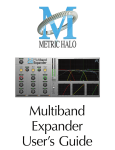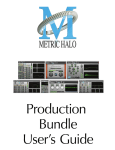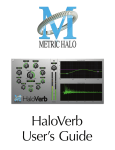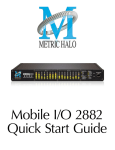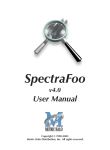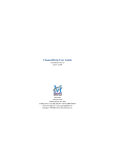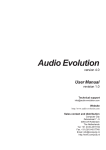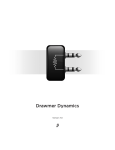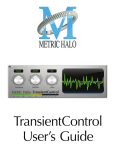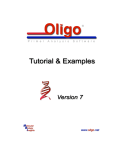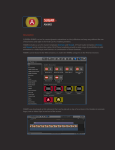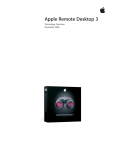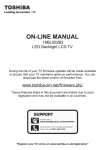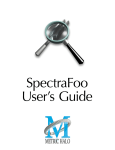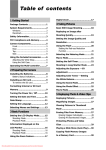Download ChannelStrip 3 Users Guide
Transcript
ChannelStrip 3 Users Guide Metric Halo Revision: v1.0.5 Publication date Mon Jun 24 12:11:12 EDT 2013 Copyright © 2013 Metric Halo. MH Production Bundle, ChannelStrip 3, Character, HaloVerb, Multiband Dynamics, Multiband Expander, Precision DeEsser, and TransientControl are our trademarks. All other trademarks are the property of their respective owners. Table of Contents I. Installation .................................................................................................................................... 8 1. System Requirements .......................................................................................................... 10 2. Installation ......................................................................................................................... 11 Macintosh ...................................................................................................................... 11 Windows ....................................................................................................................... 15 GarageBand ................................................................................................................... 16 Update Notification ........................................................................................................ 21 II. ChannelStrip 3 ........................................................................................................................... 22 3. Introduction ....................................................................................................................... 25 4. Operation .......................................................................................................................... 27 Control Knob ................................................................................................................. 27 Toggle Button ................................................................................................................. 28 Fader ............................................................................................................................. 28 Filter Type ...................................................................................................................... 29 Sidechain Routing Switch ................................................................................................ 29 Sidechain Listen Button ................................................................................................... 30 Compressor Character ..................................................................................................... 30 User Interface Control ..................................................................................................... 30 Tooltip Control ............................................................................................................... 30 Graphs Disclosure Control .............................................................................................. 30 Peak Meter ..................................................................................................................... 31 Gain Reduction Meter ..................................................................................................... 31 Peak, RMS, VU Output Meter .......................................................................................... 31 EQ Transfer Function ...................................................................................................... 32 Spectragraph Analyzer .................................................................................................... 33 Dynamics Knee .............................................................................................................. 34 Auto Enables .................................................................................................................. 34 5. Processing .......................................................................................................................... 35 A Detailed Description .................................................................................................... 35 Input Conditioning .......................................................................................................... 35 Gate/Expander ................................................................................................................ 36 Theory Of Operation .............................................................................................. 36 Gate Enable ........................................................................................................... 37 Threshold Control ................................................................................................... 37 Attack Control ........................................................................................................ 37 Release Control ...................................................................................................... 37 Using The Sidechain Key Input w/Selectable Filter ..................................................... 37 Sidechain Listen Button ........................................................................................... 37 Sidechain Routing Button ........................................................................................ 37 Sidechain Filter Enable ............................................................................................ 37 Filter Type Button ................................................................................................... 37 Filter Band Boost/Cut Control .................................................................................. 38 Filter Band Frequency ............................................................................................. 38 Filter Bandwidth ..................................................................................................... 38 Compressor .................................................................................................................... 38 Theory Of Operation .............................................................................................. 39 Audio Dynamics ..................................................................................................... 39 Compressor Enable ................................................................................................. 39 Post EQ ................................................................................................................. 39 Auto Gain .............................................................................................................. 39 Compressor Knee Control ........................................................................................ 39 3 ChannelStrip 3 Users Guide Manual Make-Up Gain ........................................................................................... Compressor Character ............................................................................................. Threshold Control ................................................................................................... Ratio Control .......................................................................................................... Attack Control ........................................................................................................ Release Control ...................................................................................................... Using The Sidechain Key Input w/Selectable Filter ..................................................... Sidechain Listen Button ........................................................................................... Sidechain Routing Button ........................................................................................ Sidechain Filter Enable ............................................................................................ Filter Type Button ................................................................................................... Filter Band Boost/Cut Control .................................................................................. Filter Band Frequency ............................................................................................. Filter Bandwidth ..................................................................................................... Equalizer ........................................................................................................................ Theory Of Operation .............................................................................................. Master Enable Button .............................................................................................. Filter Type Button ................................................................................................... Filter Enable Button ................................................................................................ Filter Band Boost/Cut Control .................................................................................. Filter Band Frequency ............................................................................................. Filter Bandwidth ..................................................................................................... Controlling The EQ With The Transfer Function ........................................................ Master Gain ........................................................................................................... Delay Section ................................................................................................................. Limiter ........................................................................................................................... III. Working with Hosts ................................................................................................................... 6. Pro Tools (Mac/Win) ........................................................................................................... Plug-in Window ............................................................................................................. Key Commands .............................................................................................................. 7. AU Hosts (Mac) .................................................................................................................. Logic ............................................................................................................................. Plug-in Window ..................................................................................................... GarageBand ................................................................................................................... Inserting CS3 in GarageBand ................................................................................... Plug-in Window ..................................................................................................... IV. Appendices ............................................................................................................................... A. Key Commands .................................................................................................................. B. Service and Support ............................................................................................................ C. Changelog ......................................................................................................................... 4 41 41 41 41 41 42 42 42 42 42 42 42 42 42 43 44 45 45 45 46 46 46 46 46 46 46 48 50 50 51 52 52 52 53 53 54 55 57 58 59 List of Figures 2.1. MH ChannelStrip.pkg ............................................................................................................... 2.2. Opening Dialog ....................................................................................................................... 2.3. License Agreement ................................................................................................................... 2.4. Accepting the License Agreement .............................................................................................. 2.5. Selecting the Installation Disk ................................................................................................... 2.6. Selecting the Installation Location ............................................................................................. 2.7. Giving the Installer Permission .................................................................................................. 2.8. Installation Complete ............................................................................................................... 2.9. MH ChannelStrip Installer msi .................................................................................................. 2.10. Opening Dialog ..................................................................................................................... 2.11. Permission to Write Files ........................................................................................................ 2.12. Installation Complete .............................................................................................................. 2.13. MHChannelStripGB.pkg .......................................................................................................... 2.14. Opening Dialog ..................................................................................................................... 2.15. License Agreement ................................................................................................................. 2.16. Accepting the License Agreement ............................................................................................ 2.17. Starting the Installation ........................................................................................................... 2.18. Giving the Installer Permission ................................................................................................ 2.19. Enter the Serial Number ......................................................................................................... 2.20. Installation Complete .............................................................................................................. 2.21. Installation Error ..................................................................................................................... 2.22. Authorizer(CS-GB3) ................................................................................................................ 2.23. Selcting the Software .............................................................................................................. 2.24. Authorization Method ............................................................................................................. 2.25. Registration Information .......................................................................................................... 3.1. ChannelStrip's User Interface ................................................................................................... 4.1. Swept Knob ........................................................................................................................... 4.2. Plus/Minus Knob .................................................................................................................... 4.3. Spread Knob .......................................................................................................................... 4.4. Limiter Knob .......................................................................................................................... 4.5. Toggle Button (Off) ................................................................................................................. 4.6. Toggle Button (On) ................................................................................................................. 4.7. Master Fader .......................................................................................................................... 4.8. Peaking/Parametric .................................................................................................................. 4.9. Low Cut ................................................................................................................................ 4.10. High Cut .............................................................................................................................. 4.11. Low Shelf ............................................................................................................................. 4.12. High Shelf ............................................................................................................................ 4.13. Bandpass .............................................................................................................................. 4.14. Sidechain Routing Switch ...................................................................................................... 4.15. Sidechain Listen Button (Disabled) ......................................................................................... 4.16. Sidechain Listen Button (Enabled) ........................................................................................... 4.17. Compressor Character Switch ................................................................................................ 4.18. UI Size Control .................................................................................................................... 4.19. Tooltip Control ..................................................................................................................... 4.20. Graph Disclosure Button ....................................................................................................... 4.21. Peak Meter ........................................................................................................................... 4.22. Gain Reduction Meter ........................................................................................................... 4.23. Output Meter ....................................................................................................................... 4.24. EQ Transfer Function ............................................................................................................ 4.25. Spectragraph Display ............................................................................................................ 5 11 11 12 12 13 13 14 14 15 15 16 16 17 17 17 18 18 19 19 19 20 20 20 21 21 26 27 27 27 27 28 28 28 29 29 29 29 29 29 29 30 30 30 30 30 30 31 31 31 32 33 ChannelStrip 3 Users Guide 4.26. Dynamics Knee .................................................................................................................... 5.1. Signal Flow: Compressor is Pre-EQ .......................................................................................... 5.2. Signal Flow: Compressor is Post-EQ ......................................................................................... 5.3. Gate/Expander ........................................................................................................................ 5.4. Compressor ............................................................................................................................ 5.5. Knee Control at 0 ................................................................................................................... 5.6. Knee Control at 1 ................................................................................................................... 5.7. Knee Control at -0.5 ............................................................................................................... 5.8. EQ Section ............................................................................................................................. 5.9. Peaking/Parametric .................................................................................................................. 5.10. Low Cut ............................................................................................................................... 5.11. High Cut .............................................................................................................................. 5.12. Low Shelf ............................................................................................................................. 5.13. High Shelf ............................................................................................................................ 5.14. Bandpass .............................................................................................................................. 5.15. Limiter ................................................................................................................................. 6.1. Pro Tools Plug-in Window ...................................................................................................... 6.2. Compare Button ..................................................................................................................... 6.3. Automation Window, Showing ChannelStrip's Parameters .......................................................... 7.1. Logic's Plug-in Window .......................................................................................................... 7.2. Select the Track ....................................................................................................................... 7.3. Insert the Plug-in ..................................................................................................................... 7.4. ChannelStrip Inserted ............................................................................................................... 7.5. Accessing the Plug-in Settings ................................................................................................... 7.6. ChannelStrip's User Interface .................................................................................................... 7.7. GarageBand's Plug-in Settings ................................................................................................... 6 34 35 35 36 38 40 40 40 44 45 45 45 45 45 45 46 50 50 51 52 53 53 53 53 54 54 List of Tables 6.1. Pro Tools Key Commands ........................................................................................................ A.1. Tooltip Control ........................................................................................................................ A.2. Control Knob Modifiers ............................................................................................................ A.3. Numeric Field Modifiers .......................................................................................................... A.4. Meters .................................................................................................................................... A.5. EQ Transfer Functions .............................................................................................................. A.6. Pro Tools Key Commands ........................................................................................................ 7 51 57 57 57 57 57 57 Part I. Installation Table of Contents 1. System Requirements .................................................................................................................. 2. Installation ................................................................................................................................. Macintosh .............................................................................................................................. Windows ............................................................................................................................... GarageBand ........................................................................................................................... Update Notification ................................................................................................................ 9 10 11 11 15 16 21 1. System Requirements • Pro Tools™ (Macintosh): Pro Tools 10 or higher running on a Macintosh computer. This software supports Native and AAX DSP operation. • Pro Tools™ (Windows): Pro Tools 10 or higher running on a Windows computer. This software supports Native and AAX DSP operation. • Native: Any Macintosh DAW that supports Audio Unit plug-ins. • An iLok copy protection key and account. Please note that one Production Bundle license authorizes the software on any platform. • GarageBand™: GarageBand running on a Macintosh computer. ChannelStrip 3 for GarageBand is functionally the same as other versions of ChannelStrip 3 with the following exceptions: • ChannelStrip 3 for GarageBand will only run in GarageBand. If inserted in another host, it will mute audio every five seconds. • There is no sidechain support. • ChannelStrip 3 for GarageBand does not include technical support via phone. 10 2. Installation Screenshots to illustrate the installation process are from the Production Bundle, but the process is the same for individual plug-ins. Macintosh Please note – The following graphics show installation on an OS 10.7 system; the process may be slightly different in other versions of the OS, but the basic concepts are the same. Small details such as file sizes shown may vary with subsequent releases. • Double-click the “MH ChannelStrip.pkg” application Figure 2.1: MH ChannelStrip.pkg • The installer dialog will appear: Figure 2.2: Opening Dialog Click “Continue”… • Now you will see the Metric Halo License Agreement: 11 Installation Figure 2.3: License Agreement After you have read it, click “Continue”… • Next click “Agree” to accept the License Agreement: Figure 2.4: Accepting the License Agreement • Now select the disk you would like the software to be installed to: 12 Installation Figure 2.5: Selecting the Installation Disk We recommend installing for all users unless you have a specific reason not to. Select the drive and click “Continue”… • Next, you have the option to select the location on the disk you would like the software to be installed to: Figure 2.6: Selecting the Installation Location We recommend that you use the standard installation location unless you have a specific reason not to. The standard locations are: 13 Installation • Plug-ins – (drivename)/Library/Application Support/Avid/Audio/Plug-Ins/MH Plug-Ins • Presets – (drivename)/Library/Application Support/Digidesign/Plug-In Settings Click “Install”… • You must now enter the name and password you use to log in to your computer, to give the Installer permission to write the software: Figure 2.7: Giving the Installer Permission Enter your credentials and click “Install Software”… • Once the installer has finished, you'll see this dialog: Figure 2.8: Installation Complete If you do not see the “Installation Successful” message, contact MH Support. • The final step is to go to http://www.ilok.com/ and install the software license to your iLok key. That’s it! Enjoy using ChannelStrip! 14 Installation Windows There are two versions of each Windows installer: • Installers that end in .msi are intended for 32 bit versions of Windows, and install the 32 bit version of the plug-in(s). • Installers that end in _x64.msi are intended for 64 bit versions of Windows, and install the 32 bit and 64 bit versions of the plug-in(s). This allows you to run Pro Tools 10 or 11 on a 64 bit machine. These installation instructions refer to the 32 bit installer, but the process is the same for 64 bit installations. Please note – The following graphics show installation on an Windows 7 system; the process may be slightly different in other versions of the OS, but the basic concepts are the same. Small details such as file sizes shown may vary with subsequent releases. • Double-click the “MHChannelStripInstaller.msi” application Figure 2.9: MH ChannelStrip Installer msi • The installer dialog will appear: Figure 2.10: Opening Dialog After you have read the Metric Halo License Agreement, click the “I accept the terms of the License Agreement” checkbox and click “Install” • Windows will ask for permission to write the files: 15 Installation Figure 2.11: Permission to Write Files Click “Yes” to begin the installation. • Once the files have been written you will see the completion dialog: Figure 2.12: Installation Complete Click “Finish” to close the installer. If you do not see the “Installation Successful” message, contact MH Support. • The final step is to go to http://www.ilok.com/ and install the software license to your iLok key. That’s it! Enjoy using ChannelStrip! GarageBand Installing your Metric Halo software product is a simple process: • Double-click the “MHChannelStripGB.pkg” application 16 Installation Figure 2.13: MHChannelStripGB.pkg • The installer dialog will appear: Figure 2.14: Opening Dialog Click “Continue”… • Now you will see the Metric Halo License Agreement: Figure 2.15: License Agreement After you have read it, click “Continue”… 17 Installation • Next click “Agree” to accept the License Agreement: Figure 2.16: Accepting the License Agreement • Click the “Install” button: Figure 2.17: Starting the Installation • You must now enter the name and password you use to log in to your computer, to give the Installer permission to write the software: 18 Installation Figure 2.18: Giving the Installer Permission Click “Install Software” to begin writing files. • Next you will need to enter your serial number: Figure 2.19: Enter the Serial Number Click "Install" to continue. • Once the installer has finished, you'll see this dialog: Figure 2.20: Installation Complete If you do not see the “Installation Successful” message or see this dialog: 19 Installation Figure 2.21: Installation Error contact MH Support. Once you have installed ChannelStrip 3 for GarageBand, you will need to authorize it. • Double click the Authorizer application: Figure 2.22: Authorizer(CS-GB3) • Make sure that that ChannelStrip for GarageBand 3 is listed, and click “Authorize”: Figure 2.23: Selcting the Software • The authorizer will now ask how you would like to proceed: 20 Installation Figure 2.24: Authorization Method You may use our online form or call to register your software, but the quickest and easiest method is to register online with the compter you are installing the software on. If this is the case, click “Yes” and enter your registration info: • Figure 2.25: Registration Information Fill in all required information and click “OK” That’s it! Enjoy using ChannelStrip 3! Update Notification ChannelStrip 3 will automatically check to see if there's a newer version available (if your computer is connected to the internet). If so, the version number in the UI will turn into an update notice. Click on the notice and a browser window will open to our download page, where you may download the newest installer. 21 Part II. ChannelStrip 3 Table of Contents 3. Introduction ............................................................................................................................... 4. Operation .................................................................................................................................. Control Knob ......................................................................................................................... Toggle Button ......................................................................................................................... Fader ..................................................................................................................................... Filter Type .............................................................................................................................. Sidechain Routing Switch ........................................................................................................ Sidechain Listen Button ........................................................................................................... Compressor Character ............................................................................................................. User Interface Control ............................................................................................................. Tooltip Control ....................................................................................................................... Graphs Disclosure Control ...................................................................................................... Peak Meter ............................................................................................................................. Gain Reduction Meter ............................................................................................................. Peak, RMS, VU Output Meter .................................................................................................. EQ Transfer Function .............................................................................................................. Spectragraph Analyzer ............................................................................................................ Dynamics Knee ...................................................................................................................... Auto Enables .......................................................................................................................... 5. Processing .................................................................................................................................. A Detailed Description ............................................................................................................ Input Conditioning .................................................................................................................. Gate/Expander ........................................................................................................................ Theory Of Operation ...................................................................................................... Gate Enable ................................................................................................................... Threshold Control ........................................................................................................... Attack Control ................................................................................................................ Release Control .............................................................................................................. Using The Sidechain Key Input w/Selectable Filter ............................................................. Sidechain Listen Button ................................................................................................... Sidechain Routing Button ................................................................................................ Sidechain Filter Enable .................................................................................................... Filter Type Button ........................................................................................................... Filter Band Boost/Cut Control .......................................................................................... Filter Band Frequency ..................................................................................................... Filter Bandwidth ............................................................................................................. Compressor ............................................................................................................................ Theory Of Operation ...................................................................................................... Audio Dynamics ............................................................................................................. Compressor Enable ......................................................................................................... Post EQ ......................................................................................................................... Auto Gain ...................................................................................................................... Compressor Knee Control ................................................................................................ Manual Make-Up Gain ................................................................................................... Compressor Character ..................................................................................................... Threshold Control ........................................................................................................... Ratio Control .................................................................................................................. Attack Control ................................................................................................................ Release Control .............................................................................................................. Using The Sidechain Key Input w/Selectable Filter ............................................................. Sidechain Listen Button ................................................................................................... 23 25 27 27 28 28 29 29 30 30 30 30 30 31 31 31 32 33 34 34 35 35 35 36 36 37 37 37 37 37 37 37 37 37 38 38 38 38 39 39 39 39 39 39 41 41 41 41 41 42 42 42 ChannelStrip 3 Sidechain Routing Button ................................................................................................ Sidechain Filter Enable .................................................................................................... Filter Type Button ........................................................................................................... Filter Band Boost/Cut Control .......................................................................................... Filter Band Frequency ..................................................................................................... Filter Bandwidth ............................................................................................................. Equalizer ................................................................................................................................ Theory Of Operation ...................................................................................................... Master Enable Button ...................................................................................................... Filter Type Button ........................................................................................................... Filter Enable Button ........................................................................................................ Filter Band Boost/Cut Control .......................................................................................... Filter Band Frequency ..................................................................................................... Filter Bandwidth ............................................................................................................. Controlling The EQ With The Transfer Function ................................................................ Master Gain ................................................................................................................... Delay Section ......................................................................................................................... Limiter ................................................................................................................................... 24 42 42 42 42 42 42 43 44 45 45 45 46 46 46 46 46 46 46 3. Introduction ChannelStrip is a plug-in for digital audio workstations which provides the essential basic channel processing found in the channel strip of a modern mixing console. Processing functions include: • • • • • • • • Input level control Phase Invert Expander/Gate with filtered sidechain Compressor with filtered sidechain 6 band Parametric EQ Channel delay Limiter Advanced metering ChannelStrip 3 has several notable new features not present in ChannelStrip 2: • • • • • • • • Updated and resizable user interface Sidechain listen Scalable gain reduction meters New “MIO” compressor character SpectraFoo™ spectrum analysis Limiter Fully interpolated EQ section with scalable display Processes are automatically enabled when adjusted 25 Introduction Figure 3.1: ChannelStrip's User Interface 26 4. Operation As with most channel strips, ChannelStrip provides many copies of controls that are all operated in a similar manner. The ChannelStrip user interface uses a few different control elements to control all of the processing. These elements are: Control Knob Control Knobs are used to control the value of various continuous parameters of a process. Examples of these types of parameters include: Attack time, Release Time, Threshold, etc. There are four styles of encoders: Figure 4.1: Swept Knob The rings around these encoders sweep from a minimum to maximum value, normally from left to right. One exception is the compressor threshold, which sweeps from right to left. Figure 4.2: Plus/Minus Knob The rings around these encoders start at 12 o'clock and sweep to either side. These knobs are used for gain control, where straight up is no gain change, turning to the left cuts the signal and turning to the right boosts it. Figure 4.3: Spread Knob The rings around these encoders start at 12 o'clock and spread to both sides equally as the control is increased. These knobs are used for bandwidth controls. Figure 4.4: Limiter Knob The ring around this encoder displays the amount of gain reduction from the limiter. The display sweeps around the encoder from right to left, with a fully left display indicating 12dB of gain reduction. 27 Operation You can change the value of each knob in a number of different ways. Click and drag the knob to change the value continuously. Dragging up or to the right will increase the value, while dragging down or to the left will decrease the value. If you hold down the Mac ⌘ (Command) key or Windows Control key when you click, you will be able to adjust the value with finer precision. If you hold the Mac ⌥ (Option) key or Windows Alt key when you click, the knob will reset to its default value. You may also double-click a knob to reset it. Click on the number (readout) of the knob to display a text entry field that allows you to type in a number directly. The pop-up will remain active until you dismiss it by clicking somewhere else or hitting the return, enter, tab, Mac ⌘. (Command + .), Windows Alt key or ESC keys. Hit return or enter to confirm the value and dismiss the pop-up. Hit the tab key to confirm the value and display an entry field for the next control. ⇧tab (Shift + tab) will display the entry field for the previous control). Hit the Mac ⌘. (Command + .), Windows Control. (Control + .) or ESC (Escape) to dismiss the pop-up and cancel the change. When you enter a number into the pop-up entry, you can use a couple of abbreviations: “k” multiplies the number by 1000 and “m” divides the number by 1000. So if you want to enter 16,500 Hz you can just type 16.5k. Toggle Button Figure 4.5: Toggle Button (Off) Figure 4.6: Toggle Button (On) Toggle buttons are simple on/off switches. They light up when they are on and are dark when they are off. You toggle the state of the button by clicking on it. These buttons are used to enable processor sections, select keying sources and to switch the order of processing within ChannelStrip. Fader Figure 4.7: Master Fader The fader is unique in that only one fader is used in the interface for ChannelStrip. It works in much the same fashion as the control knobs. Instead of dragging up/right or down/left to change the value, you directly drag the fader knob. The other “tricks” described for the knobs also work with the fader. The fader is used to control the master output gain of the plug-in before the limiter stage. 28 Operation Filter Type Each filter band in the strip (6 EQ bands and 2 Side-chain bands) has a filter type control that allows you to choose the shape of the filter applied by that band. Each band provides 6 different types of filter shapes: Figure 4.8: Peaking/Parametric Peaking/Parametric – a second order bell-shaped parametric boost/cut filter. Boost/cut has a range of ± 24 dB. When the boost is greater than +15 dB the filter gains a resonant quality. The center frequency of the filter can be any frequency between 20 Hz and 20 kHz. The bandwidth of the filter is continuously variable between 0.1 octaves and 2.5 octaves. Figure 4.9: Low Cut Low Cut – a 12 dB/octave low cut filter with a -3dB point that is continuously adjustable between 20 Hz and 20 kHz. Figure 4.10: High Cut High Cut – a 12 dB/octave high cut filter with a -3dB point that is continuously adjustable between 20 Hz and 20 kHz. Figure 4.11: Low Shelf Low Shelf – a shelving filter that applies boost/cut to low frequencies. Boost/cut is limited to +12 dB/– 24dB. The bandwidth controls the dip/peak that is added at the end of the transition band. Figure 4.12: High Shelf High Shelf – a shelving filter that applies boost/cut to high frequencies. Boost/cut is limited to +12 dB/– 24dB. The bandwidth controls the dip/peak that is added at the end of the transition band. Figure 4.13: Bandpass Bandpass – a bandpass filter with 6dB per octave skirt on the high and low ends of the pass band. The width of the pass band can be adjusted between 0.1 octaves and 2.5 octaves and the center of the pass band is continuously adjustable between 20 Hz and 20 kHz. You can select from these types via three different methods. Each time you click on the Filter Type control, the band will switch to the next type in the list (and wrap to the beginning when you hit the end of the list). If you click and hold the mouse button, a pop-up menu listing all of the types will appear after about 1/4 of a second. You can select the type directly from this pop-up menu. If you want to access the menu without having to wait, hold down the Mac ⌃ (Control) key when you click or right-click (Mac/Win). Sidechain Routing Switch Figure 4.14: Sidechain Routing Switch 29 Operation Each sidechain routing switch allows you to control the signal sent to the sidechain input of its associated gate or compressor. By default, the level detectors in the dynamics processors key off of the signal that they are processing. Under some circumstances, you may want to use a different signal to open the gate or compress the signal. Most DAWs allow you to specify an input or bus as the source for ChannelStrip’s sidechain input. The Sidechain routing switches allow you to choose the input to the level detector from the sidechain (key) input or the signal being processed. To toggle the state, click the Sidechain routing switch. Sidechain Listen Button Figure 4.15: Sidechain Listen Button (Disabled) Figure 4.16: Sidechain Listen Button (Enabled) The sidechain listen button allows you to listen to the signal being sent to the gate or compressor sidechain input. This allows you to monitor the audio being routed from the key input, and hear the effect of sidechain filtering. Compressor Character Figure 4.17: Compressor Character Switch The compressor character controls the time constants of the compressor section. It functions identically to the Filter Type control, except there are only four choices: Smooth, Warm, Fast and MIO. See the section on the compressor for more information. User Interface Control Figure 4.18: UI Size Control This button switches the overall ChannelStrip user interface between small, medium and large sizes to accomodate different display resolutions. Tooltip Control Figure 4.19: Tooltip Control This button toggles the tooltip display. When enabled, tooltips wil be shown when the mouse hovers over a control. When the tooltip display is disabled, you may still see tooltips by holding down the ? key and hovering over a control. Graphs Disclosure Control Figure 4.20: Graph Disclosure Button The Graphs disclosure control allows you to show and hide ChannelStrip’s display graphs. This allows you to maximize screen real-estate while still providing details on the processing when they are needed. Click on this control to toggle the visibility of the graphs. ChannelStrip will automatically make the plug-in window smaller when you hide the graphs. 30 Operation ChannelStrip also uses a number of standard visual representations to give you feedback about what is happening within the processor. These elements are: Peak Meter Figure 4.21: Peak Meter ChannelStrip provides a peak-reading meter at the input stage of each processing block. The meter uses the fast PPM standard for decay time (0.9 seconds per 20 dB) and the digital PPM standard legend for calibration. On the dynamics sections (gate and compressor) a white bar is visible on top of the meter and indicates the current detector level. For the dynamics sections the processor threshold is indicated by the red slider over the input peak meter. This slider can be manipulated directly with the mouse. The top segment of the meter (above 0dB) is used as a clip indicator and is illuminated red if the input section of the processor detects an over. The clip light remains illuminated until you click on the meter. Mac ⌥ (Option)–click or Windows Alt-click any meter to reset the clip lights on all of the meters in ChannelStrip. When ChannelStrip is running in stereo mode, this meter shows the higher of the two input levels and will detect an over on either input channel. Gain Reduction Meter Figure 4.22: Gain Reduction Meter The gain reduction meter, which has an orange bar and grows down from 0 dB, shows the amount of attenuation being applied by its associated dynamics processor at any given time. If you right-click (Mac/Win) or Mac ⌃ (Control) click on the meter, you may set the scale of the gain reduction meter to any of the following values: • • • • • 54 dB 24 db 12 db 6 db 3 db Peak, RMS, VU Output Meter Figure 4.23: Output Meter 31 Operation For the main output stage of ChannelStrip we have provided meters driven with SpectraFoo™ metering technology. These meters show, in addition to the peak metering provided for the input stages, RMS level and VU level. The peak level is represented by the floating colored bar, the RMS level by the solid colored bar and the VU level by the overlaid gray bar. Both the Peak and RMS level are represented with fast PPM ballistics. The VU meter shows IEEE standard 300 ms RMS average level. When ChannelStrip is on a mono insert there will be a single meter. When ChannelStrip is running in stereo mode the left meter shows the left channel output level and the right meter shows the right channel output level. The output section clip lights activate if there is an over in the output stage or in any of the processing section input stages. It is reset by clicking on the meter; Mac ⌥ (Option)–click or Windows Alt-click to reset the clip lights on all the meters. A Note About Clipping Indicators: The clip lights do not mean that the plug-in is clipping; it means that the audio level in the DSP is currently over 0 dBFS. If you do not lower the signal level you run a chance of actually clipping the input of another processor or D/A convertor. EQ Transfer Function Figure 4.24: EQ Transfer Function The following information applies to the EQ processing block as well as the sidechain filters of the gate and compressor. The EQ transfer function is a combination of a visual representation of how the EQ is processing the signal and an intuitive controller for the associated filter bands. This display is sometimes called a “Cartesian Graph” by other EQ manufacturers. The horizontal axis provides frequency calibration in Hertz (Hz). The vertical axis provides level calibration in decibels (dBr). The heavy green line indicates the relative change in level at each frequency that is created by the combined effects of all of the active bands in the equalizer. Each EQ band is represented by a colored dot in the transfer function. The color of the dot matches the color of the rings around the knobs for the corresponding EQ band. The band that is currently being edited will be displayed along with the overall response curve. If the associated band is a parametric filter there will also be two smaller colored dots that can be used to control the bandwidth of the filter. Clicking on a large colored dot and dragging will allow you to adjust the frequency and gain of the 32 Operation associated band. Mac ⌘ (Command)–click, Windows Control-click or double-click the dot to toggle the band enable. Mac ⌥ (Option)–click or Windows Alt the dot to adjust the bandwidth (dragging right increases the bandwidth, left decreases the bandwidth). Mac ⌘⌥ (Command + Option)–click or Windows Control+Altclick the dot to switch the band filter type. Click and drag the smaller dots associated with a larger dot to adjust the filter bandwidth. To dismiss the filter curve, click anywhere in the black area of the transfer function. This will deselect the filter point, and the only trace displayed will be the green master curve. If you right-click (Mac/Win) or Mac ⌃ (Control) click on the transfer function, you will see a menu to set the vertical dB scale for the display. The values are: • • • • • ±3 dB ±6 dB ±12 dB ±24 dB ±36 dB This menu also allows you to specify whether adjusting a filter causes it to automatically be enabled. This preference is for all instances of ChannelStrip 3. Spectragraph Analyzer Clicking the SpectraFoo™ logo in the upper right hand corner of the transfer function will activate the spectragraph, showing the realtime frequency analysis of your signal: Figure 4.25: Spectragraph Display The traces are: • • • • White: Left channel instantaneous display Red: Right channel instantaneous display Yellow: Left channel average display Blue: Right channel average display The instantaneous trace updates in real-time, allowing you to see the immediate peak level of your audio. The average trace displays the level as averaged over a short period, giving you a more general view. 33 Operation The spectragraph analyses the signal post-filter, allowing you to see the effect of your EQ filter(s); the EQ's spectragraph is also after the Master Gain and Limiter. The spectragraph may only be used in one window at a time and will toggle between sections. For example, if your are viewing the spectragraph in the EQ window and then click the the SpectraFoo™ icon in the compressor's sidechain window, the spectragraph will switch to that window. To disable the spectragraph entirely, click the active 'Foo icon. If you right-click (Mac/Win) or Mac ⌃ (Control) click on the transfer function, you will see a menu to set options for the spectragraph: • • • • Show Instantaneous Trace: Toggles whether the spectragraph shows the instant response of your audio. Show Average Trace: Toggles whether the spectragraph shows the averaged response of your audio. Show Left Channel: Toggles the left channel spectragraph display. Show Right Channel: Toggles the right channel spectragraph display. These settings are stored for each transfer function window separately, and for each instance of ChannelStrip. Dynamics Knee Figure 4.26: Dynamics Knee ChannelStrip contains a Dynamics Knee diagram for the gate and compressor processing sections. The diagram provides feedback on the response of the associated dynamics processor. Both the horizontal and vertical axes are calibrated in dBFS. The horizontal axis corresponds to the input level and the vertical axis represents the output level. The heavy line shows the dynamic of the associated processing block. This means that if you sent in a sine wave at a given input level, the output level would be equal to the level shown on the graph. When the processor is working with real dynamic signals, the graph is a good approximation of the response when the attack is fast and the release is slow. In most cases, however, the dynamic response of the processor will not match its static response. In order to represent this, we have included a “bouncing ball” meter for both the gate and the compressor. This metering is shown as a red circle that is overlaid on the knee diagram. The red circle is placed so its horizontal position is equal to the instantaneous input level and its vertical level is equal to the instantaneous output level. Examining this meter while you are adjusting the dynamics controls will provide you with a great deal of information about how the processor is operating and how the controls interact. Auto Enables The processing sections of ChannelStrip will automatically enable when one of its parameters are adjusted. For example if the EQ master enable is off, adjusting any EQ parameter will turn it on. This way you will never make “phantom” adjustments where you make adjustments and hear no change. The same is true for the sidechain filters. 34 5. Processing A Detailed Description In this chapter we'll discuss what each processing block does and how the controls work. Figure 5.1: Signal Flow: Compressor is Pre-EQ Figure 5.2: Signal Flow: Compressor is Post-EQ The block diagrams above illustrate the overall structure of the processing system provided by ChannelStrip. The diagrams do not indicate the various metering blocks. The configuration is controlled by the “Post EQ” button in the compressor and it changes the path of the signal through the processor. The internal signal switching provided by ChannelStrip allows you to explore the various effects of re-ordering processing blocks without having to waste time stopping the transport, removing and reinserting plug-ins and then finally restarting the transport. Now lets examine the various processing blocks indicated in the diagram. Input Conditioning After the signal is routed to ChannelStrip it runs through the phase invert block. This block is controlled by the “ø Inv” switch. When the phase invert is enabled the polarity of the signal will be flipped. The signal is cross- 35 Processing faded between the uninverted and inverted states so the signal level will drop briefly when you flip the state of the phase invert switch, but it will not introduce a glitch or click into your audio. After the the phase invert block the audio is routed through an input gain block that provides input gain of up to +24 dB. You can use this gain to condition signals that are low in level. This input gain may also be used to pad out signals by up to –24 dB. While you may find this attenuation useful to just bring down the level through the strip simply and quickly, you must realize that this gain is applied after the signal reaches ChannelStrip and will not pad out any clipping that occurs in the A/D converters or in a plug-in that is inserted before ChannelStrip. The input gain is controlled by the “In Gain” knob. Gate/Expander The next processing block is the Gate. The gate is used to adjust the low level dynamics of the signal being processed. Through the use of the external side-chain the gate can be used to do acoustic triggers. In addition, the side chain filter may be used to make the control of the dynamics frequency sensitive. This can be useful when you are trying to gate out a noisy signal that has a specific, very strong signal in a limited frequency range when you want the gate to open. Figure 5.3: Gate/Expander Theory Of Operation Based upon your setting for the sidechain routing switch, either the Pro Tools sidechain input signal or the channel signal is fed to the sidechain filter. The sidechain filter provides one band of equalization that may be used to accentuate or cut certain frequencies (parametric or shelf filters) or limit the key to a certain range of frequencies (cut or bandpass filters). You control the filter type and the filter parameters with the filter type button and the “dB”, “Hz” and “BW” knobs. You can enable the side chain filter with the green “SC Ena” button. After the sidechain signal has been processed by the sidechain filter it is measured by a level detector that determines the instantaneous level of the signal (in the case that ChannelStrip is running in stereo mode the detector is linked with the other channel in the stereo pair and the higher level of the two channels is used). When the gate is enabled the signal will be attenuated based on how much the detected level is below the threshold you set with the “Thresh” knob. The dynamic behavior of the opening and closing of the gate is controlled with the “Attack” and “Release” knobs. 36 Processing Gate Enable This button is in the Master Enables section. When this button is off, the gate will not change the signal. Threshold Control The “Thresh” knob controls the level at which the gate opens and closes. When the detector level is above the threshold level the gain through the gate is 0 dB. When the detector level is below the threshold level, the gain is reduced at a ratio of 1:2. This means that if the detector is 3dB below the threshold the signal output will be 6dB below the threshold or 3dB below the input level. The gate threshold level is also indicated by the red bar above the gate input meter. You can adjust the threshold level using this indicator as well as by using the “Thresh” knob. Attack Control The “Attack” knob allows you to adjust how quickly the gain reduction is decreased to 0 dB when the detector level goes above the threshold level. When this control is set to Auto, the attack rate is controlled by how much the detector level is above the threshold. When you set the attack to another value other than “Auto” that value, measured in milliseconds, will control how quickly the gate opens. The maximum value is 100 milliseconds. Attack times other than auto are especially useful when using the gate as a trigger. If the key signal is a little early you can use the attack to delay the trigger slightly. It is also useful to remove the initial transients of impulsive sounds. Release Control The “Release” knob controls the release time of the gate. This parameter is measured in milliseconds and can range from 5 ms to 5 sec. The release time controls how quickly the gate closes after the detector drops below the threshold value. For settings below 90 ms or so the gate closes pretty abruptly and may introduce unwanted artifacts into your audio, depending on the signal. Using The Sidechain Key Input w/Selectable Filter The gate provides a sidechain that processes audio before the detector determines the current level. The sidechain can process either the channel signal or some external side chain input signal. Sidechain Listen Button This button (the speaker icon next to the Sidechain Enable) allows you to monitor the audio being sent to the gate's detector. This will allow you to listen to external audio that is being routed to the sidechain, and also hear the effect of the sidechain filter. When you are done listening to the sidechain, click this button again to hear ChannelStrip's normal output. Sidechain Routing Button This button (labeled “C” in the illustration) is used to control the routing of the input signal to the gate sidechain. When the button is in the “C” state, the signal used by the sidechain is the signal being processed by ChannelStrip. When the button is in the “SC” state, the signal used by the sidechain is the input or bus selected in the “side chain input” pop-up in your DAW's plug-in window header. If nothing is selected in that pop-up, the input to the sidechain will be silence and the gate will never open. Sidechain Filter Enable This button (labeled “SC Ena”) allows you to toggle the sidechain filter in and out of the audio path to the detector. Filter Type Button This button (indicating a peaking/parametric filter in the illustration) is used to select the filter type of the single band of side chain EQ. You may choose from the 6 different types of filters detailed in the filter type section in “Operating the Strip”. 37 Processing Filter Band Boost/Cut Control Use this knob (labeled “dB” in the illustration) to adjust the gain of the filter band for the peaking, high and low shelf filter types. This parameter is ignored for the other filter types. In the shelving filters the maximum boost is +12 dB and the maximum cut is -24 dB. In the peaking filters the maximum boost/cut is ± 24 dB. When you increase the boost for a filter band above 15 dB, the filter gets nicely aggressive and resonant. Filter Band Frequency Use this knob (labeled “Hz” in the illustration) to adjust the characteristic frequency of the filter. For the peaking and bandpass filter types this controls the center frequency of the filter. For the high and low cut filter types this control adjusts the 3 dB point of the filter. For the shelving filters this control adjusts the shelf transition point. Filter Bandwidth Use this knob (labeled “BW” in the illustration) to adjust the characteristic width of the filter. This control only has effect for peaking, shelving and bandpass filter types. Please note that this parameter controls the bandwidth (measured in octaves), not the quality factor (or “Q”). If you have been using Q controls, the numbers will be backwards from what you are used to. Small numbers mean narrow filters and large numbers mean wide filters. For peaking and bandpass filter types, this parameter controls the bandwidth of the filter in octaves. For the high and low shelving filter types this parameter adjusts the amount of dip/peak and the slope of the shelf. When this parameter is set to 0.1 you will get the largest dip/slope available and when the parameter is 2.5, you will get a classic first order shelf (which has a transition band that is about 1 decade wide; e.g. if it is a high shelf with a frequency of 10 kHz and a gain of 10 dB, the gain will be at 0 dB near 1kHz). Compressor Depending on the state of the “Post EQ” button (the default state is for the compressor to come first in the signal chain), the next block in the signal processing chain is the compressor. The compressor is used to adjust the high–level dynamics of a signal. As with the gate, the sidechain can be used to make the compressor frequency sensitive (so it can be used like a de-esser) or to reduce the gain of the signal in response to some external event (this allows the compressor to be used like a ducker or for other creative effects). Figure 5.4: Compressor Often, you will want to compress the signal before you equalize it. Sometimes you will need to equalize the signal before you compress it. ChannelStrip provides that flexibility with the “Post EQ” button. This is a very 38 Processing important part of ChannelStrip because it allows you to test different processing scenarios quickly and easily. It also allows you to compare the two different approaches without having to stop the transport so you can get a much more visceral comparison. Theory Of Operation The operation of the compressor is very similar to the gate. Based upon your setting for the sidechain routing switch, either the sidechain input signal or the channel signal is fed to the sidechain filter. The sidechain filter provides one band of equalization that may be used to accentuate or cut certain frequencies (parametric or shelf filters) or limit the key to a certain range of frequencies (cut or bandpass filters). You control the filter type and the filter parameters with the filter type button and the “dB”, “Hz” and “BW” knobs. You can enable the sidechain filter with the enable button. After the sidechain signal has been processed by the sidechain filter it is measured by a level detector that determines the instantaneous level of the signal (in the case that ChannelStrip is running in stereo mode the detector is linked with the other channel in the stereo pair and the higher level of the two channels is used). When the compressor is enabled the signal will be attenuated based on how much the detected level is above the threshold you set with the “Thresh” knob and what compression ratio is set with the “Ratio” knob. The dynamic behavior of the opening and closing of the gate is controlled with the “Attack” and “Release” knobs and the compressor character switch. Audio Dynamics Compressors are important in controlling the dynamic range of the source material you are working with. While the instruments, your ears, the microphones and your digital audio workstation all have dynamic ranges that are greater than 100 dB, most reproduction and delivery media have significantly reduced dynamic ranges. Compression is used, in its simplest form, to help reduce the dynamic range of your project or elements of the project to a range that is reproducible. It does this by making the soft material louder and the loud material softer. This type of processing can also be used to change the character of the sound instead of just adjusting the dynamic range. The compressor in ChannelStrip excels at both types of processing. Compressor Enable This button is in the Master Enables section. When this button is off, the compressor section will not change the signal. The order of this button will change depending on whether the compressor is set to “Post EQ”. Post EQ The “Post EQ” button places the compressor section after the equalizer in the signal chain. By providing the capability to switch the routing on the fly, ChannelStrip allows you to determine the most effective routing for your particular signal quickly and easily. Auto Gain When the “Auto Gain” button is enabled the compressor automatically adjusts the makeup gain in the compressor output stage so that if the manual “O Gain” knob is set to 0 dB the static gain reduction for a 0 dB input level will be about 7 dB. This number was chosen because it works well with the default settings of the “Attack” and “Release” knobs to provide enough pad to not clip fast transients. The “O Gain” knob will apply additional trim to the internal automatic gain. If the threshold is set very low (e.g. –60 dB) and auto gain is enabled, you will not be able to add very much manual gain (only about 1 – 2 dB) even though the readout on the knob will go up to + 30 dB. This is an internal limitation of the compressor. Compressor Knee Control The “Knee” knob allows you to adjust shape of the compressor transfer function when the Compressor Character is set to MIO (the Knee control has no effect for the other compressor character algorithms and will not be visible in those modes). 39 Processing When the Knee control is set to 0, the transfer function of the compressor is a classic “hard-knee” in which the compressor applies no gain reduction when the detector is below the threshold, and the gain is reduced by the ratio when the detector level is above the threshold. Figure 5.5: Knee Control at 0 When you increase the Knee parameter from 0 to 1 the knee of the transfer function gradually softens until the compressor functions as a soft-knee compressor when the Knee parameter is 1. Figure 5.6: Knee Control at 1 You can also adjust the Knee parameter to negative values, which has the effect introducing a “kink” in the compressor transfer function at the threshold. This can yield useful results on percussive material. Figure 5.7: Knee Control at -0.5 40 Processing Manual Make-Up Gain The “O Gain” knob allows you to manually adjust the makeup gain applied to the signal after the gain reduction applied by the compressor. If the Auto Gain switch is off, this is the amount of makeup gain applied. If the Auto Gain switch is on, then this parameter is a trim added to the internally computed makeup gain. The makeup gain is enabled and disabled along with the rest of the compressor. Compressor Character Use the compressor character button to determine the overall dynamic characteristics of the compressor. There are three “classic” ChannelStrip 2 settings to choose from: • Smooth – appropriate for full mixes or single instruments that do not have big transients. Provides very smooth compression with few artifacts, no distortion and limited transient control. • Warm – the most versatile setting for the compressor. Balances transient control with audibility of the compression. Appropriate for a wide range of signals including harmonic instruments with large transients (e.g. Plucked bass). • Fast – provides significant transient control at the expense of transparency and added distortion. Appropriate for impulsive signals with significant transients. Supports very fast (e.g. 1 sample) gain reduction attacks. as well as a new algorithm for ChannelStrip 3: • MIO – provides the compressor characteristics from the MIOStrip compressor that runs on our interfaces. This compressor algorithm is very different from the other three. The MIO compressor generates its gain reduction directly from the detector level. The Attack and Release parameters directly control the measurement of the detector level. This allows the MIO compressor to function as a limiter as well as a compressor and a leveling amplifier. The MIO compressor algorithm also supports an adjustable Knee. In general, the MIO algorithm is more flexible and controllable than the other algorithms, and as a result, we have made it the factory default for ChannelStrip 3. Threshold Control The “Thresh” knob controls the level at which the compressor begins to reduce the gain applied to the signal. When the detector level is below the threshold level, no gain reduction is applied. As the detector level increases above the threshold level, the gain is reduced as indicated by the knee diagram associated with the compressor. The compressor knee is soft. The ratio increases as the difference between the detector level and the threshold increases. The compressor threshold level is also indicated by the red bar above the gate input meter. You can adjust the threshold level using this indicator as well as by using the “Thresh” knob. Ratio Control The “Ratio” knob controls the ‘terminal’ ratio used to compute the gain reduction of the compressor. When the ratio associated with the soft knee hits the ratio specified by the ratio knob, the knee ‘hardens’ and remains at the same constant ratio. If you set the ratio to 1000:1 the compressor will have a soft knee for all input levels and thresholds. This makes the compressor work like a classic all tube limiter/compressor. Attack Control The “Attack” knob allows you to adjust how quickly the gain reduction is increases when the detector level goes above the threshold level. This control is calibrated in milliseconds and values range from 0 to 500 ms. The compressor has an 8 sample look-ahead buffer that allows it to have an “instant attack” when you set the attack time to 0. Fast attack times will control the transients of impulsive sounds. Use longer attack times to let the transients through but control the sustains. 41 Processing Release Control The “Release” knob controls the release time of the compressor. This knob is calibrated in milliseconds and can range from 5 ms to 5 sec. The release time controls how quickly the gain reduction returns to zero after the detector drops below the threshold value. For settings below 40 ms or so the compressor releases pretty abruptly and may introduce unwanted artifacts into your audio, depending on the signal. In addition, be careful making the release time faster than the attack time. Using The Sidechain Key Input w/Selectable Filter The compressor provides a sidechain that processes audio before the detector determines the current level. The sidechain can process either the channel signal or some external side chain input signal. Sidechain Listen Button This button (the speaker icon next to the Sidechain Enable) allows you to monitor the audio being sent to the compressor's detector. This will allow you to listen to external audio that is being routed to the sidechain, and also hear the effect of the sidechain filter. When you are done listening to the sidechain, click this button again to hear ChannelStrip's normal output. Sidechain Routing Button This button (labeled “C” in the illustration) is used to control the routing of the input signal to the compressor sidechain. When the button is in the “C” state, the signal used by the sidechain is the signal being processed by ChannelStrip. When the compressor is in the “SC” state, the signal used by the sidechain is the input or bus selected in the “side chain input” pop-up in your DAW's plug-in window header. If nothing is selected in that pop-up, the input to the sidechain will be silence and the compressor will never compress. You can use the filter to achieve a de-essing effect by using the bandpass filter to only compress when the “ess” is present. You can also achieve a combined compression/de-essing effect by using a peaking filter to accentuate the “ess” frequencies and adjusting the threshold and ratio to perform compression when the “ess” is not present and limiting when the “ess” is present. Take a look a the presets for examples. Sidechain Filter Enable This button (labeled “SC Ena”) allows you to toggle the sidechain filter in and out of the audio path to the detector. Filter Type Button This button (indicating a peaking/parametric filter in the illustration) is used to select the filter type of the single band of side chain EQ. You may choose from 6 different types of filters detailed in the filter type section in “Operating the Strip”. Filter Band Boost/Cut Control Use this knob (labeled “dB” in the illustration) to adjust the gain of the filter band for the peaking, high and low shelf filter types. This parameter is ignored for the other filter types. In the shelving filters the maximum boost is +12 dB and the maximum cut is -24 dB. In the peaking filters the maximum boost/cut is ± 24 dB. When you increase the boost for a filter band above 15 dB, the filter gets very aggressive and resonant. Filter Band Frequency Use this knob (labeled “Hz” in the illustration) to adjust the characteristic frequency of the filter. For the peaking and bandpass filter types this controls the center frequency of the filter. For the high and low cut filter types this control adjusts the 3 dB point of the filter. For the shelving filters this control adjusts the shelf transition point. Filter Bandwidth Use this knob (labeled “BW” in the illustration) to adjust the characteristic width of the filter. This control only has effect for peaking, shelving and bandpass filter types. Please note that this parameter controls the bandwidth 42 Processing (measured in octaves), not the quality factor (or “Q”). If you have been using Q controls, the numbers will be backwards from what you are used to. Small numbers mean narrow filters and large numbers mean wide filters. For peaking and bandpass filter types, this parameter controls the bandwidth of the filter in octaves. For the high and low shelving filter types this parameter adjusts the amount of dip/peak and the slope of the shelf. When this parameter is set to 0.1 you will get the largest dip/slope available and when the parameter is 2.5, you will get a classic first order shelf (which has a transition band that is about 1 decade wide; e.g. if it is a high shelf with a frequency of 10 kHz and a gain of 10 dB, the gain will be at 0 dB near 1kHz). Equalizer The next processing section is the Equalizer. The equalizer may appear in the signal chain before the compressor section depending on the state of the “Post EQ’ button in the compressor. The equalizer in ChannelStrip is a very flexible, fully parametric 6 band equalizer. Each band in the equalizer can be configured as any of the six available filter types. Each parameter in the equalizer is continuously adjustable throughout its entire range, so you can set the exact EQ that you need. 43 Processing Figure 5.8: EQ Section Theory Of Operation The equalizer in ChannelStrip work just like every other EQ under the sun with the exceptions that is more flexible, more efficient and sounds better. By adjusting the various parameters associated with each band in the EQ you can control the tonal and timbral balance of the signal. The resonance effect of the peaking filters provides a facility to recreate acoustic resonances that are lacking in the source material with which you are working. One of the nicest aspects of the filters in ChannelStrip is their time domain performance. These filters ring significantly less than comparable filters in other signal processors. This allows you equalize signals without the normal time smearing that you encounter with other equalizers. 44 Processing Master Enable Button This button is in the Master Enables section. When this button is off, the EQ section will not change the signal. The order of this button will change depending on whether the compressor is set to “Post EQ”. Filter Type Button This button (indicating a peaking/parametric filter in the illustration) is used to select the filter type of the single band of side chain EQ. You may choose from 6 different types of filters: Figure 5.9: Peaking/Parametric Peaking/Parametric – a second order bell-shaped parametric boost/cut filter. Boost/cut has a range of ± 24 dB. When the boost is greater than +15 dB the filter gains a resonant quality. The center frequency of the filter can be any frequency between 20 Hz and 20 kHz. The bandwidth of the filter is continuously variable between 0.1 octaves and 2.5 octaves. Figure 5.10: Low Cut Low Cut – a 12 dB/octave low cut filter with a -3dB point that is continuously adjustable between 20 Hz and 20 kHz. Figure 5.11: High Cut High Cut – a 12 dB/octave high cut filter with a -3dB point that is continuously adjustable between 20 Hz and 20 kHz. Figure 5.12: Low Shelf Low Shelf – a shelving filter that applies boost/cut to low frequencies. Boost/cut is limited to +12 dB/– 24dB. The bandwidth controls the dip/peak that is added at the end of the transition band. Figure 5.13: High Shelf High Shelf – a shelving filter that applies boost/cut to high frequencies. Boost/cut is limited to +12 dB/– 24dB. The bandwidth controls the dip/peak that is added at the end of the transition band. Figure 5.14: Bandpass Bandpass – a bandpass filter with 6dB per octave skirt on the high and low ends of the pass band. The width of the pass band can be adjusted between 0.1 octaves and 2.5 octaves and the center of the pass band is continuously adjustable between 20 Hz and 20 kHz. Filter Enable Button Use this toggle button to enable each filter band. When the filter band is turned off the signal will pass through the filter unchanged. 45 Processing Filter Band Boost/Cut Control Use this knob (labeled “dB” in the illustration) to adjust the gain of the filter band for the peaking, high and low shelf filter types. This parameter is ignored for the other filter types. In the shelving filters the maximum boost is +12 dB and the maximum cut is -24 dB. In the peaking filters the maximum boost/cut is ± 24 dB. When you increase the boost for a filter band above 15 dB, the filter gets very aggressive and resonant. You can use this feature to good effect when you need to reconstruct a resonance for a recorded instrument that lacks one. For example, you could place a narrow +24 dB peaking filter between 60 and 80 Hz on a kick drum track that lacked a “belly” for the drum. Filter Band Frequency Use this knob (labeled “Hz” in the illustration) to adjust the characteristic frequency of the filter. For the peaking and bandpass filter types this controls the center frequency of the filter. For the high and low cut filter types this control adjusts the 3 dB point of the filter. For the shelving filters this control adjusts the shelf transition point. Filter Bandwidth Use this knob (labeled “BW” in the illustration) to adjust the characteristic width of the filter. This control only has effect for peaking, shelving and bandpass filter types. Please note that this parameter controls the bandwidth (measured in octaves), not the quality factor (or “Q”). If you have been using Q controls, the numbers will be backwards from what you are used to. Small numbers mean narrow filters and large numbers mean wide filters. For peaking and bandpass filter types, this parameter controls the bandwidth of the filter in octaves. For the high and low shelving filter types this parameter adjusts the amount of dip/peak and the slope of the shelf. When this parameter is set to 0.1 you will get the largest dip/slope available and when the parameter is 2.5, you will get a classic first order shelf (which has a transition band that is about 1 decade wide; e.g. if it is a high shelf with a frequency of 10 kHz and a gain of 10 dB, the gain will be at 0 dB near 1kHz). Controlling The EQ With The Transfer Function As described in the operation guide earlier in this manual, you can control each band of the EQ directly from the EQ transfer function display associated with the 6 band equalizer. Master Gain The one fader in ChannelStrip’s user interface controls the master gain of the plug-in. This fader is not shown in the illustration of the EQ section, but it is shown in the overall processor illustration at the beginning of this manual. The “Master Gain” fader allows you to add up to +10 dB of gain or up to -160 dB of attenuation to the output signal from the EQ processor or compressor block (depending on the processor order) before going to the limiter. Delay Section You can add up to 255 samples of delay to the output of ChannelStrip. This is useful for dynamically slipping tracks, doing acoustical time alignment or compensating for the delay of other plug-ins in your mix. You can use automation on the delay to create interesting dynamic flanging effects. Simply duplicate a track and enable automation on the delay control for one of the copies. As you change the delay through one of the copies you will create a nice, controllable phasey flanging sound. Limiter Figure 5.15: Limiter 46 Processing The final processing block in ChannelStrip 3 is a limiter. The limiter can be used to ensure that the final output of ChannelStrip doesn't distort due to extreme EQ boosts. This also makes it very easy to use ChannelStrip as a mastering plug-in on your final mix bus. The limiter threshold may be set between 0 and -12 dB using the Limiter Threshold knob. The gain reduction is displayed via the ring around the encoder, sweeping from right to left. The limiter applies autogain to the audio when engaged; as the threshold is lowered, the output gain is increased a complementary amount. 47 Part III. Working with Hosts Table of Contents 6. Pro Tools (Mac/Win) ................................................................................................................... Plug-in Window ..................................................................................................................... Key Commands ...................................................................................................................... 7. AU Hosts (Mac) .......................................................................................................................... Logic ..................................................................................................................................... Plug-in Window ............................................................................................................. GarageBand ........................................................................................................................... Inserting CS3 in GarageBand ........................................................................................... Plug-in Window ............................................................................................................. 49 50 50 51 52 52 52 53 53 54 6. Pro Tools (Mac/Win) Your Pro Tools software provides a standard interface for controlling various aspects of AAX plug-ins. While you should refer to your Pro Tools documentation for a complete description, we will summarize the most important points here. If you wish to use a plug-in on multiple channels in your mix, you should Mac ⌥ (Option) or Windows Alt insert the plug-in on the desired channels and ensure that the plug-in is inserted on the same insert point on every channel (e.g. ensure that the plug-in is on insert “a” for every channel). This will allow you to take advantage of a number of time saving features provided by Pro Tools. Plug-in Window The illustration below shows the standard Pro Tools plug-in window. Figure 6.1: Pro Tools Plug-in Window If you have inserted your plug-in(s) as we suggested above you can click on the channel name pop-up in the upper left hand corner of the window (labeled “Audio 1” above) to switch from channel to channel. The next pop-up in the window (labeled “b” above) allows you to switch to another insert on the same channel. You would use this to switch to another plug-in on the same channel. The bypass button allows you to bypass the effects of the plug-in. The Pro Tools editor/librarian button (the small, downward pointing triangle) provides access to a pop-up menu that allow you to manage presets and libraries of settings for the plug-in. Use this menu to save libraries or open groups of libraries. See your Pro Tools documentation for more information. The preset library pop-up menu (labeled “factory default” above) shows the active preset name (in italics if the current settings do not match the library). Click this pop-up to select from the available presets. The “Compare” button indicates when the controls have changed for the current preset settings. Click this button to toggle between your current settings and the preset settings. Figure 6.2: Compare Button Clicking the “Automation” button causes Pro Tools to display the plug-in automation configuration dialog box: 50 Pro Tools (Mac/Win) Figure 6.3: Automation Window, Showing ChannelStrip's Parameters This dialog box allows you to enable any or all of the processing parameters for automation. When a parameter is enabled for automation you will be able to record and play-back automated parameter changes directly from your Pro Tools session. If the channel that the plug-in is inserted on has automation enabled Character will highlight the controls associated with the automated parameters: • • • • Off: No color Read: Green Touch, Latch, Write: Red Controlled via control surface: Blue Key Commands The following key commands are used to when clicking on controls: Command Display Automation Dialog Show Automation Breakpoint Set Parameter to Default Value Table 6.1. Pro Tools Key Commands Mac Key Sequence Windows Key Sequence ⌥⌘ (Option + Command)–click Alt + Control–click ⌥ (Option)–click or double–click Alt-click or double-click ⌃⌘ (Control + Command)–click 51 Control + Windows–click 7. AU Hosts (Mac) The Production Bundle is compatible with any Core Audio compatible host. Support for features like sidechains differ between hosts; please check your host's documentation for more info. As an example, we'll look at using the Production Bundle in Logic. Logic Logic provides a standard interface for controlling various aspects of AU plug-ins. While you should refer to your Logic documentation for a complete description, we will summarize the most important points here. If you wish to use a plug-in on multiple channels in your mix, you should click and drag the selection marquee over the desired channels in the Mixer, and insert the plug-in on any one of them; this will insert the plugin at the same insert point on every channel. Plug-in Window The illustration below shows the standard Logic plug-in window. Figure 7.1: Logic's Plug-in Window If you have inserted the plug-in as we suggested above you can click on the “Show Channel Strip” pop-up to switch between instances of the plug-in on different channels. The “Show Insert” pop-up allows you to switch to another insert on the same channel. You would use this to switch to another plug-in on the same channel. When the Link button (the button with the chain icon) is on, a single plug-in window is used to display all plug-ins. Turn this off if you would like to have multiple plug-in windows open at once. The View button is used to toggle between the generic AU user interface for the plug-in and the standard view provided by Metric Halo. The Bypass button allows you to bypass the effects of the plug-in. The effects of all the processing sections within the plug-in are removed from the audio chain when the plug-in is bypassed. The Compare button allows you to toggle between the current settings and the settings as they were before the last paramenter change. By using the Compare button you may “A/B” changes in settings. The left/right arrows move backward and forward between presets. The Logic preset menu (the pop-up menu with the small downward pointing triangle next to the left/right arrows) allows you to manage presets and libraries of settings for the plug-ins. Use this menu to save libraries or open groups of libraries. See your Logic documentation for more information. The Copy and Paste buttons allow you to copy settings from one instance of a plug-in and paste them into the same plug-in on other channels without creating a preset. The sidechain input pop-up menu allows you to select from any mono input or bus in your system and feed it to the internal sidechain bus within plug-ins that have sidechain support. You then use the sidechain routing buttons within the plug-in UI to assign the sidechain bus to the dynamics detectors. This menu is only present when a sidechain-enabled plug-in is viewed. 52 AU Hosts (Mac) GarageBand GarageBand provides a standard interface for using plug-ins. While you should refer to the GarageBand documentation for a complete description, we will summarize the most important points here. Inserting CS3 in GarageBand To insert ChannelStrip, first higlight the track you wish to put the plug-in on. You do this by clicking the name of the track in the left hand side of GarageBand: Figure 7.2: Select the Track Now go to the right side of the window and click on the "Edit" tab. Click on an empty space in the "Effects" window and select "ChannelStrip" from the menu. Figure 7.3: Insert the Plug-in ChannelStrip will now be inserted on your track. Figure 7.4: ChannelStrip Inserted You can quickly listen to the presets that ship with ChannelStrip by clicking on the menu that says "Manual". If you would like adjust the settings yourself, put your mouse over the icon to the left of the ChannelStrip slot; you will see it turn into a picture of sliders: Figure 7.5: Accessing the Plug-in Settings 53 AU Hosts (Mac) Click on the slider icon to open the ChannelStrip UI. Figure 7.6: ChannelStrip's User Interface Plug-in Window The illustration below shows the settings in the GarageBand plug-in window. Figure 7.7: GarageBand's Plug-in Settings • On: This checkbox lets you turn the plug-in's processing on and off. • Preset list: Clicking on this menu will allow you to select from ChannelStrip's presets. The "Manual" setting starts as a blank slate where you can make your own adjustments. You can select a preset to get a different sound, then switch back to Manual to hear the settings you dialed in. If you have made adjustments to ChannelStrip that you would like to use again, select "Make Preset…" and name your preset. You will now be able to use these settings on other tracks, and in other songs. 54 Part IV. Appendices Table of Contents A. Key Commands .......................................................................................................................... 57 B. Service and Support .................................................................................................................... 58 C. Changelog ................................................................................................................................. 59 56 A. Key Commands There are several key commands used as modifiers combined with mouse actions: Command Table A.1. Tooltip Control Mac Key Sequence Windows Key Sequence Show tooltips Hold ? down Hold ? down Command Table A.2. Control Knob Modifiers Mac Key Sequence Windows Key Sequence Fine control ⌘ (Command)-click and drag Reset to default value Command ⌥ (Option)-click or double-click Control-click and drag Alt-click or double-click Table A.3. Numeric Field Modifiers Mac Key Sequence Windows Key Sequence Confirm & dismiss numeric pop-up return, enter return, enter Confirm & move to previous entry ⇧-tab (Shift + tab) ⇧-tab (Shift + tab) Confirm & move to next entry tab Dismiss numeric pop-up & cancel ⌘. (Command + .), ESC change tab Control. (Control + .), ESC Command Table A.4. Meters Mac Key Sequence Windows Key Sequence Reset Clip ⌥ (Option)–click the meter Alt-click the meter Command Table A.5. EQ Transfer Functions Mac Key Sequence Windows Key Sequence Toggle band enable ⌘ (Command)–click or double-click frequency dot Adjust bandwidth (click then drag) ⌥ (Option)–click frequency dot Change filter type ⌘⌥ (Command + Option)–click frequency dot Access EQ TF settings ⌃ (Control) or right-click graph Command Display Automation Dialog Show Automation Breakpoint Set Parameter to Default Value Control-click or double-click frequency dot Alt-click frequency dot Control+Alt-click frequency dot Right-click graph Table A.6. Pro Tools Key Commands Mac Key Sequence Windows Key Sequence ⌥⌘ (Option + Command)–click Alt + Control–click ⌥ (Option)–click or double–click Alt-click or double-click ⌃⌘ (Control + Command)–click 57 Control + Windows–click B. Service and Support Metric Halo takes great pride in the reputation for customer service and support that we have built. If you have any problems, questions, or suggestions please get in touch with us at: • http://mhsecure.com/support • [email protected] • (727) 725-9555 Note for ChannelStrip 3 for GarageBand Users ChannelStrip 3 for GarageBand is not eligible for phone support. Please use one of the online methods listed above above. Please keep us informed about your successes and projects. We love to hear from you! 58 C. Changelog Please note that this changelog incorporates changes for all plug-ins across all supported formats. 1.0.5: • • • • • • • • • • • • • • • • • • • • • Fix alignment issue with some UI elements in ChannelStrip [AU] Fix issue in some hosts where parameter updates may be lost Fix for potential crash on deinstantiation in Multiband Plugins [AU] Fix for crash in some hosts (specifically FCPX) due to initialization on a thread [AU] Fix meter reset for MultibandCompressor [AU] Fix meter reset for MultibandExpander [AU] Fix potential crash in HaloVerb [AU] Fix meter reset for Character Fix meter allocation for MultibandExpander Fix analysis buffer allocation for MultibandExpander Fix analysis buffer allocation for MultibandCompressor Fix analysis buffer allocation for De-Esser [AAX] Add support for PT11 and 64-bit build [AAX-Win] Implement full optimization for host code (decreases CPU usage) [AAX-Win] Implement 64-bit Installers Sign Binaries for PT 10.3.x / PT 11 Fix auto-suffixing of parameter readouts to deal with negative numbers [TransientControl] Fix (extend) range of the sustain parameter Fix locking for threaded plotter of crossover functions to avoid potential race condition and crash [Mac] Fix problem with signing 32-bit binaries (led to corrupted PT 10.3.x plugins) Fix Gain Reduction meters for PT reported meters (so that PT11 and control surfaces render them properly) 1.0.4: • • • • • • • • • Fixed potential problem with licensing code when plugin scanner opens and closes plugin very quickly Moved drawing of HaloVerb impulse response onto background thread for responsiveness Moved drawing of Multiband dynamic EQ response onto background thread for responsiveness Added caching for background image of plugin window to reduce CPU used for drawing static image Fixed incorrect interpretation of wet/dry parameter when computing HaloVerb impulse response display Optimized computing HaloVerb impulse response display Optimized redraw of EQ response curve Fixed problem with incorrectly showing that preset was changed (when it wasn't) via Compare button Deferred redraw of UI until host sends parameter changed message -- fixes PT UI pauses when changing certain parameters • Fixed problem with parameter notification that caused recording of automation for ChannelStrip to not function • Added work-around to fix problems with multi-parameter touch automation recording in Logic (worksaround Logic bug) 1.0.3: 59 Changelog • • • • • • • • • • • • • • • • • • • • Soft Interpolation of band Bypass in ChannelStrip EQ Fix slight transparency on some controls Fixed problem with tool-tip tracking Fixed problem with phantom mouse clicks after dragging beyond UI boundary Fixed problem with silent output from CS2/CS3 on some hosts with disconnected sidechain input Fixed problem with compressor gain state on instantiation ChannelStrip: removed recall of Bypass from preset state (to match standard PT behavior) Add support for Mac OS 10.5 Add support to cancel text entry with ⌘. (Command + .) [Control. (Control + .) on Win] Fixed interpolation to support bit-clean bypass Fixed noise problem with LF high-pass filters Fix problem with tooltips appearing even if window is covered by another window or is hidden Added a preference to control auto-enable of bands to the Transfer Function popup menu in ChannelStrip 3 Fixed interpolation in ChannelStrip: • Stereo EQ bands • Compressor/Limiter threshold • Stereo Gate Fixed interpolation in Multiband Dynamics: • Compressor/Limiter threshold Knee control in ChannelStrip 3 is hidden when not in "MIO" character mode Added version number reporting and update notification Initial release for Windows AAX Initial release for Macintosh AU Initial release of ChannelStrip 3 for GarageBand 1.0.2: • Fixed issue with grunge when DSP is filled with MH Precision De-esser • Further optimized CS3, Precision De-esser, and MH MultibandDynamics, leading to an increase in instance counts • Fixed bit-cleanliness on bypassed CS3 blocks -- so now CS3 with phase invert nulls with unprocessed audio 1.0.1: • • • • • • • • • • • • Substantial optimization of the processing code, especially for HDX Accurate Cycle Counts for HDX Enhanced control surface page table layouts Fix for some corner case bugs that apparently can cause a DSP crash on heavily loaded systems Additional interpolation of various parameters in the plugins to provide glitch free parameter changes Fixed a conflict between CoreGraphics and DAE that can lead to DAE errors (DSP + Native), CPU Spiking or CPU overloads (Native) Fixed a filter stability issue for high session sample rates Fixed an issue where the average trace in the analyzer view can get stuck Reduce the size on disk and in memory of the plugins Fixed some missing control surface metering support and clip detection Fixed some small graphic anomalies Fix for detector for classic compressor in CS3 when Side-Chain filter is enabled 60 Changelog • Signed installer for Mountain Lion compatibility 1.0: Initial release for Macintosh AAX 61





























































